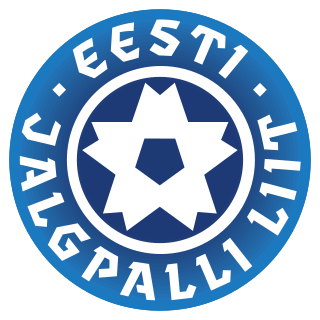
Göbekli Tepe is a Neolithic archaeological site in the Southeastern Anatolia Region of Turkey. Dated to the Pre-Pottery Neolithic, between c. 9500 and 8000 BCE, the site comprises a number of large circular structures supported by massive stone pillars – the world's oldest known megaliths. Many of these pillars are richly decorated with figurative anthropomorphic details, clothing, and reliefs of wild animals, providing archaeologists rare insights into prehistoric religion and the particular iconography of the period. The 15 m (50 ft)-high, 8 ha (20-acre) tell also includes many smaller buildings, quarries, and stone-cut cisterns from the Neolithic, as well as some traces of activity from later periods.

The Slovak Football Association is the governing body of football in Slovakia based in Bratislava. It has the ultimate responsibility for the control and development of football in Slovakia and is the body that runs the Slovakia national football teams.

The Clovis culture is a prehistoric Paleoamerican culture, named for distinct stone and bone tools found in close association with Pleistocene fauna, particularly two mammoths, at Blackwater Locality No. 1 near Clovis, New Mexico, in 1936 and 1937. It existed from roughly 11,500 to 10,800 years Before Present at the end of the last glacial period and is characterized by the manufacture of "Clovis points" and distinctive bone and ivory tools.

The Estonian Football Association is the governing body of football, beach soccer and futsal in Estonia, established on 14 December 1921. It organizes the football league, including the championship which is called Meistriliiga, Estonian Cup and the Estonian national football team. It is based in Tallinn. EJL became a member of FIFA in 1923, but following Estonia's annexation by the Soviet Union it was disbanded. It became a member again in 1992 after Estonia reinstated its independence.

Structurae is an online database containing pictures and information about structural and civil engineering works, and their associated engineers, architects, and builders. Its entries are contributed by volunteers and saved in a MySQL database.

A historic site or heritage site is an official location where pieces of political, military, cultural, or social history have been preserved due to their cultural heritage value. Historic sites are usually protected by law, and many have been recognized with the official national historic site status. A historic site may be any building, landscape, site or structure that is of local, regional, or national significance. Usually this also means the site must be at least 50 years or older.

IMDb is an online database of information related to films, television series, home videos, video games, and streaming content online – including cast, production crew and personal biographies, plot summaries, trivia, ratings, and fan and critical reviews. IMDb began as a fan-operated movie database on the Usenet group "rec.arts.movies" in 1990, and moved to the Web in 1993. Since 1998, it is now owned and operated by IMDb.com, Inc., a subsidiary of Amazon.
Enzyme kinetics is the study of the rates of enzyme-catalysed chemical reactions. In enzyme kinetics, the reaction rate is measured and the effects of varying the conditions of the reaction are investigated. Studying an enzyme's kinetics in this way can reveal the catalytic mechanism of this enzyme, its role in metabolism, how its activity is controlled, and how a drug or a modifier might affect the rate.
Canmore is an online database of information on over 320,000 archaeological sites, monuments, and buildings in Scotland. It was begun by the Royal Commission on the Ancient and Historical Monuments of Scotland. Historic Environment Scotland has maintained it since 2015. The Canmore database is part of the National Record of the Historic Environment, formerly the National Monuments Record of Scotland and contains around 1.3 million catalogue entries. It includes marine monuments and designated official wreck sites, such as the wreck of HMS Pheasant (1916).

The Virginia Landmarks Register (VLR) is a list of historic properties in the Commonwealth of Virginia. The state's official list of important historic sites, it was created in 1966. The Register serves the same purpose as the National Register of Historic Places. The nomination form for any Virginia site listed on the VLR is sent forward to the National Park Service for consideration for listing on the National Register.

The Wayback Machine is a digital archive of the World Wide Web founded by the Internet Archive, a nonprofit based in San Francisco, California. Created in 1996 and launched to the public in 2001, it allows the user to go "back in time" and see how websites looked in the past. Its founders, Brewster Kahle and Bruce Gilliat, developed the Wayback Machine to provide "universal access to all knowledge" by preserving archived copies of defunct web pages.

PageRank (PR) is an algorithm used by Google Search to rank web pages in their search engine results. It is named after both the term "web page" and co-founder Larry Page. PageRank is a way of measuring the importance of website pages. According to Google:
PageRank works by counting the number and quality of links to a page to determine a rough estimate of how important the website is. The underlying assumption is that more important websites are likely to receive more links from other websites.
Lagbe was a town of ancient Phrygia, now an archaeological site. It was situated northeast of the Lacus Karalitis. It was the seat of a bishop in the third century.
Madnasa, or Medmasa (Μέδμασα), also known as Medmasus or Medmasos (Μέδμασος), was a town in ancient Caria, at the Myndos Peninsula, and is currently an archaeological site near upper Göl, about 13 km northeast of Myndos. In 5th century BCE the city was included in the Delian League and Athenian tribute lists.
Istlada was a town of ancient Lycia; the name is known only from inscriptions and is uncertain because the end of the inscription has been lost.
Malus or Malos was a town of ancient Galatia, inhabited during Roman and Byzantine times. It was the site of the martyrdom of Theodotus of Ancyra.
Toriaeum or Toriaion was a town of ancient Lycia, inhabited during Roman and Byzantine times. During Roman times it was a Roman colony; during Byzantine times it seems to have appeared in the Synecdemus as Komistaraos.
Lysinia or Lysinoe (Λυσινόη) was a town in the north of ancient Pisidia and later assigned to Pamphylia. Hierocles has the name as Lysenara (Λυσήναρα). It was located on the south of the Ascania Lacus, and west of Sagalassus.
Takina was a town of ancient Pisidia, now an archaeological site. It may be the same town as the one called Gazena by Ptolemy and that called Tagena in the Ravenna Cosmography.











